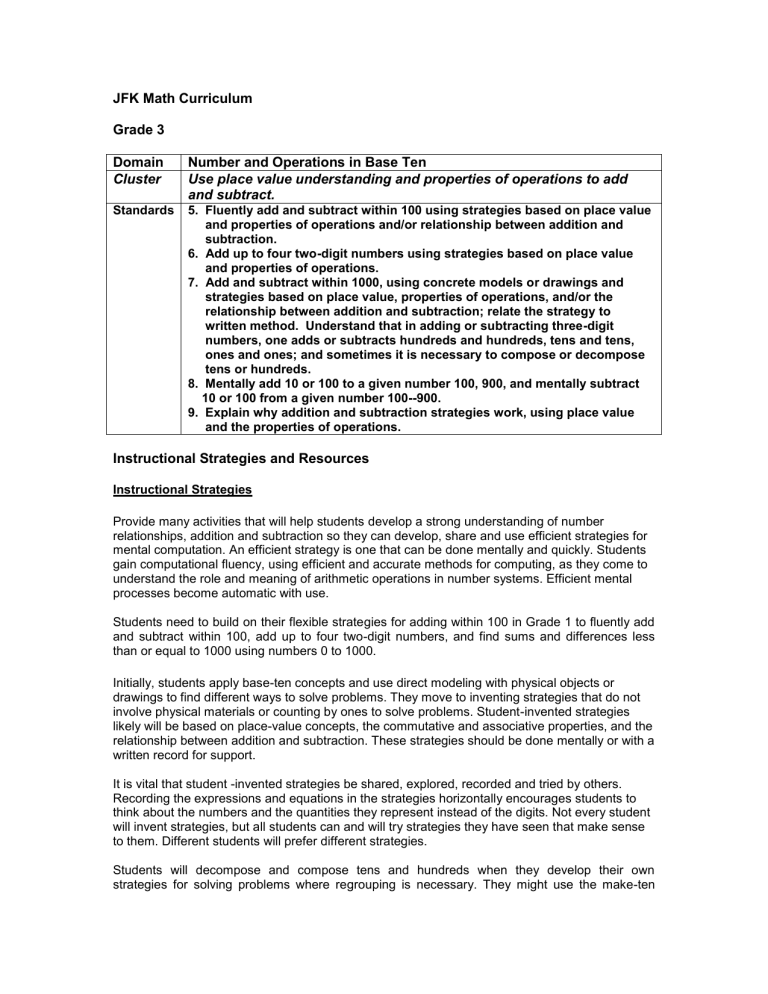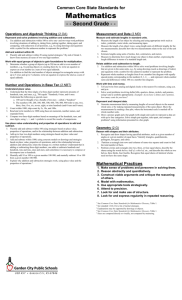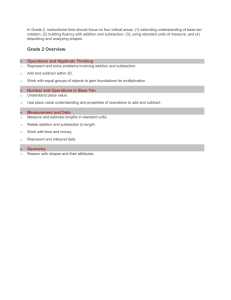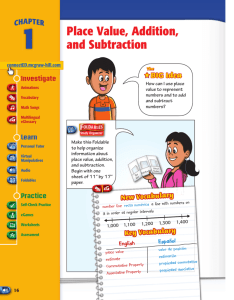Use place value understanding and properties of operations to add

JFK Math Curriculum
Grade 3
Domain Number and Operations in Base Ten
Cluster Use place value understanding and properties of operations to add and subtract.
Standards 5. Fluently add and subtract within 100 using strategies based on place value
and properties of operations and/or relationship between addition and
subtraction.
6. Add up to four two-digit numbers using strategies based on place value
and properties of operations.
7. Add and subtract within 1000, using concrete models or drawings and
strategies based on place value, properties of operations, and/or the
relationship between addition and subtraction; relate the strategy to
written method. Understand that in adding or subtracting three-digit
numbers, one adds or subtracts hundreds and hundreds, tens and tens,
ones and ones; and sometimes it is necessary to compose or decompose
tens or hundreds.
8. Mentally add 10 or 100 to a given number 100, 900, and mentally subtract
10 or 100 from a given number 100--900.
9. Explain why addition and subtraction strategies work, using place value
and the properties of operations.
Instructional Strategies and Resources
Instructional Strategies
Provide many activities that will help students develop a strong understanding of number relationships, addition and subtraction so they can develop, share and use efficient strategies for mental computation. An efficient strategy is one that can be done mentally and quickly. Students gain computational fluency, using efficient and accurate methods for computing, as they come to understand the role and meaning of arithmetic operations in number systems. Efficient mental processes become automatic with use.
Students need to build on their flexible strategies for adding within 100 in Grade 1 to fluently add and subtract within 100, add up to four two-digit numbers, and find sums and differences less than or equal to 1000 using numbers 0 to 1000.
Initially, students apply base-ten concepts and use direct modeling with physical objects or drawings to find different ways to solve problems. They move to inventing strategies that do not involve physical materials or counting by ones to solve problems. Student-invented strategies likely will be based on place-value concepts, the commutative and associative properties, and the relationship between addition and subtraction. These strategies should be done mentally or with a written record for support.
It is vital that student -invented strategies be shared, explored, recorded and tried by others.
Recording the expressions and equations in the strategies horizontally encourages students to think about the numbers and the quantities they represent instead of the digits. Not every student will invent strategies, but all students can and will try strategies they have seen that make sense to them. Different students will prefer different strategies.
Students will decompose and compose tens and hundreds when they develop their own strategies for solving problems where regrouping is necessary. They might use the make-ten
strategy (37 + 8 = 40 + 5 = 45, add 3 to 37 then 5) or (62 - 9 = 60 7 = 53, take off 2 to get 60, then
7 more) because no ones are exchanged for a ten or a ten for ones.
Instructional Strategies (cont.)
Have students analyze problems before they solve them. Present a variety of subtraction problems within 1000. Ask students to identify the problems requiring them to decompose the tens or hundreds to find a solution and explain their reasoning.
Instructional Resources/Tools
Groupable materials
Dried beans and small cups for groups of 10 beans
Linking cubes
Plastic chain links
Pregrouped materials
Base ten blocks
Hundreds chart (numbers 1-100) and blank hundreds chart
Common Misconceptions
Students may think that the 4 in 46 represents 4, not 40. Students need many experiences representing two-and three-digit numbers with groupable then pregrouped materials.
When adding two-digit numbers, some students might start with the digits in the ones place and record the entire sum. Then they add the digits in the tens place and record this sum. a ten and provide more experiences modeling addition with grouped and pregrouped base-ten materials.
When subtracting two-digit numbers, students might start with the digits in the ones place and subtract the smaller digit from the larger digit. Then they move to the tens and the hundreds places and subtract the smaller digits from the larger digits. a ten and provide more experiences modeling subtraction with grouped and pregrouped base-ten materials.
Lessons
See unit guides for units 6, Grades 3 units 1 & 3.
Connections
This cluster is connected to the Second Grade Critical Area of Focus #2, Building fluency with addition and subtraction
This cluster is connected to Understand and apply properties of operations and the relationship between addition and subtraction and Add and subtract within 20 and Use place value understanding and properties of operations to add and subtract in Grade 1, to Add and subtract within 20 in Grade 2, and to Use place value understanding and properties of operations to perform multi-digit arithmetic in Grade 3.





